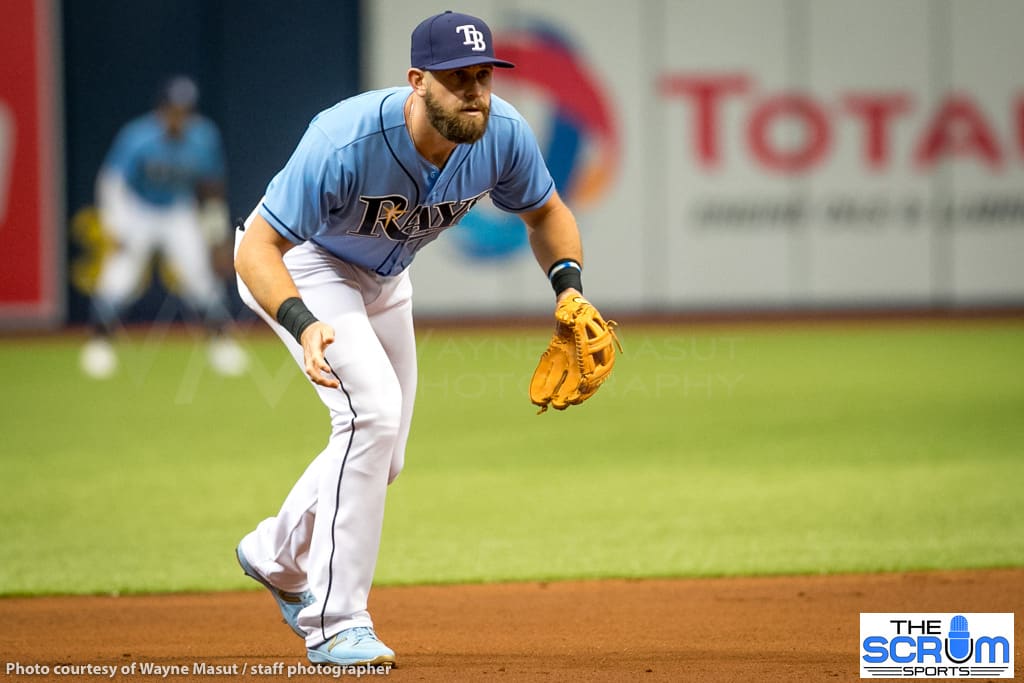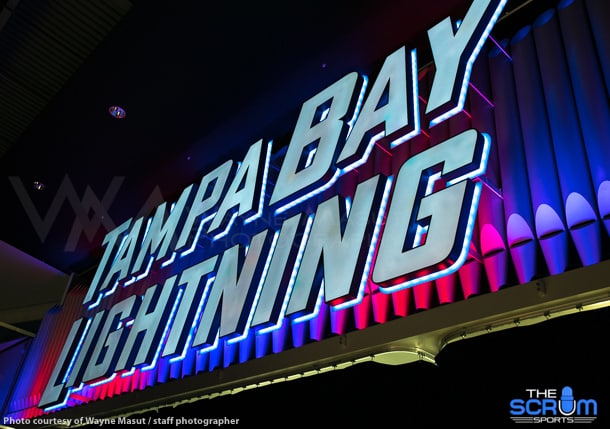
Whether the Rays go into full rebuilding mode this offseason will depend heavily on whether GM Erik Neander is able to move Evan Longoria and his soon-to-be-burdensome contract during the MLB Winter Meetings, writes J. Scott Butherus.
If the Tampa Bay Rays are going to blow up their roster this offseason in anticipation of a full overhaul, third baseman and face of the franchise Evan Longoria is the flicked Bic hovering over the fuse.
Rays general manager Erik Neander and senior vice president of baseball operations Chaim Bloom met with local media at Tropicana Field on Thursday afternoon to lay out their plans for the MLB Winter Meetings, which begin on Dec. 10 in Orlando.
They expect to be quite busy. How busy could hinge on Longoria’s future in Tampa Bay.
Per team policy, the team wouldn’t comment on specific plans for individual players. Neander did say he was “typically open-minded” when it comes to listening to offers from other teams.
Closer Alex Colome, who was most recently linked to the St. Louis Cardinals in a possible trade, and at least one of their young starters —most likely righty Jake Odorizzi — will probably be dealt at some point. If Neander is able to find a suitable trade partner that will provide a sufficient haul of young prospects, willing to take on Longoria’s ballooning contract, expect a lot of other names to come into play. It would mean the difference between opening up an Etsy Shop and going full Black Friday on Amazon.
“We have to be open to considering anything and everything,” Neander said. “A lot of that depends on where there’s interest and what we believe is the best interest of the club as we move forward.”
When Neander and company return home from Orlando at the end of the meetings, don’t be surprised if the Rays have a whole new look. That includes their franchise face.
“The reason I don’t have a no-trade clause is for situations like this. If the team decides that they want to move in a different direction they can do that,” Longoria told Mark Topkin of the Tampa Bay Times on Monday.
The Domino Effect
If Longo goes, the Rays would be more amenable to parting with starter Chris Archer and outfielder/DH Corey Dickerson, both named to the AL All-Star team last season. Both could bring a respectable haul of prospects because of the their relatively low price tag — Dickerson will make $6.4 million next season, Archer $6.25 — and future controllability.
Archer, who went 10-12 with a 4.07 ERA and 249 strike outs in 201 innings, is under contract through 2019 with team options in 2020 and 2021. Dickerson is likely to double his $3.025 million salary from last year after batting .282 with 27 home runs in his second season in St. Pete. The second-year arbitration eligible Dickerson will not become a free agent until 2020.
That could trigger a chain reaction that could see catcher Wilson Ramos and his $10.5 million guaranteed salary and outfielder Kevin Kiermaier ($5.5 million). Shortstop Adeiny Hechavarria, who expected to make approximately $5 million through the arbitration process in 2018, and second baseman Brad Miller, $4.4 million, could also find themselves on the block.
“At some point here I think the dam is going to break and really, for us, I think it’s about putting some things into action and hopefully putting this 2018 club more into focus than it has to this point,” Neander said.
Even players like outfielder Steven Souza, who is coming off of a breakout season in which he set career-highs in virtually every offensive category including HRs (30), RBIs (78), on-base percentage (.351) and slugging (.459), could become expendable at the right price. Souza is expected to make just around $3.6 million in his first year of arbitration eligibility and is under team control until 2021, making him extremely valuable to both the Rays or a potential trade partner.
“I think teams recognize that we are now into December and we are getting close to the holidays and the new year soon enough so it’s time to get things moving,” Neander said. “There are a lot of rosters out there that are not complete for 2018.”
Neander said that he would like to slash team payroll, which topped $90 million last season. His goal is to accomplish this by Opening Day, whether the team opts for a full rebuild or stands pat to try and make a run at the division in 2018.
Gambling with Both Hands
Flipping Longo for a farm-system changing haul is definitely easier said than done. There could be considerable consequences to such a deal, not the least of which is the blowback from fans. Longoria has been the face of the franchise pretty much since the former first-round pick debuted in 2008. He is the most marketable player for a franchise that sometimes struggles to sell itself. For a team that has issues with low attendance, getting rid of a fan favorite probably won’t help.
“We know first and foremost that what our fans want is a winning product on the field,” Bloom said. “They want to see us popping champagne, as we do, and reaching that ultimate goal of winning a World Series. Everything we do is with that ultimate goal in mind.”
It’s also a very real possibility that there just won’t be a sufficient market for the 32-year-old. Longoria is arguably only the third-most coveted third baseman that is available in his own division behind Baltimore’s Manny Machado and Toronto’s Josh Donaldson. Although Longoria did win his third Gold Glove at the hot corner, offensively, his .261/20/86 line from 2017 were all below his career average of .270/29/101 and has not made an All-Star squad since 2010.
Difficult decisions to be made
If the Rays are unable to move him, the team runs the risk of being hamstrung by his contract throughout a potential rebuilding process, similar to the situation that the Minnesota Twins found themselves in with Joe Mauer. Longoria made $13 million last year but will be owed $19.5 per year by the time his contract expires in 2022. Unlike Mauer, Longoria isn’t a local product. Even though Longo has a reputation for being a positive influence in the clubhouse, he might not be comfortable with losing — a lot— for an extended period.
Even if Neander gets a package that he is comfortable with, there’s no guarantee that any prospect, no matter how highly touted, will pan out at the big league level. That’s a risk the front office will have to ask themselves if they are willing to take.
Follow @JScottButherus on Twitter





